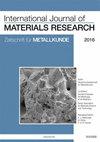Citric acid-derived nanoporous molybdenum carbide electrocatalyst for HER: Effect of porosity on HER performance
IF 0.7
4区 材料科学
Q4 METALLURGY & METALLURGICAL ENGINEERING
引用次数: 0
Abstract
The development of noble metal-free electrocatalyst for HER is crucial for sustainable green electrolytic hydrogen production. Molybdenum carbides have shown enormous potential as an economic electrocatalyst for HER. In this study, we have synthesized three Mo2C/C electrocatalysts by varying the ratios of carbon (citric acid) and molybdenum (ammonium heptamolybdate) precursors as 2:1, 1:1, and 1:2 (samples abbreviated as CAMO21, CAMO11, and CAMO12) using the carburization method. The synthesized samples are characterized by powder XRD, Raman spectroscopy, SAXS, SEM, and TEM which revealed the crystal phase, porosity, and morphological properties of the samples. The polarization curves reveal that their electrochemical activity for HER varied as CAMO12 > CAMO11 > CAMO21. EIS studies indicated that the resistance due to porosity of the samples is maximum for CAMO11, indicating that a bimodal porosity with a substantial fraction of pores near the micropore region is not beneficial for electrochemical HER.柠檬酸衍生纳米多孔碳化钼电催化剂:孔隙率对HER性能的影响
开发无贵金属电催化剂是实现可持续绿色电解制氢的关键。碳化钼作为一种经济的电催化剂已显示出巨大的潜力。在本研究中,我们通过碳(柠檬酸)和钼(七钼酸铵)前驱体的比例分别为2:1,1:1和1:2(样品缩写为CAMO21, CAMO11和CAMO12),采用渗碳法合成了三种Mo2C/C电催化剂。采用粉末XRD、拉曼光谱、SAXS、SEM和TEM对合成的样品进行了表征,分析了样品的晶相、孔隙率和形貌特征。极化曲线显示其电化学活性为CAMO12 > CAMO11 > CAMO21。EIS研究表明,CAMO11样品的孔隙阻力最大,表明在微孔区附近有大量孔隙的双峰孔隙不利于电化学HER。
本文章由计算机程序翻译,如有差异,请以英文原文为准。
求助全文
约1分钟内获得全文
求助全文
来源期刊
CiteScore
1.30
自引率
12.50%
发文量
119
审稿时长
6.4 months
期刊介绍:
The International Journal of Materials Research (IJMR) publishes original high quality experimental and theoretical papers and reviews on basic and applied research in the field of materials science and engineering, with focus on synthesis, processing, constitution, and properties of all classes of materials. Particular emphasis is placed on microstructural design, phase relations, computational thermodynamics, and kinetics at the nano to macro scale. Contributions may also focus on progress in advanced characterization techniques. All articles are subject to thorough, independent peer review.

 求助内容:
求助内容: 应助结果提醒方式:
应助结果提醒方式:


